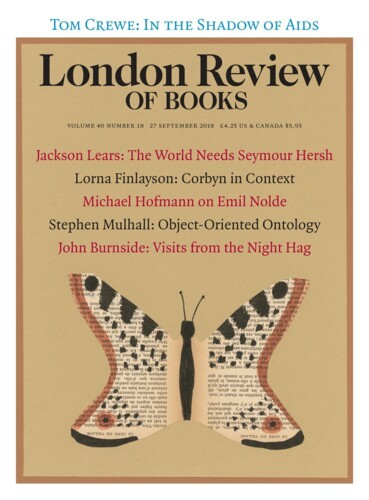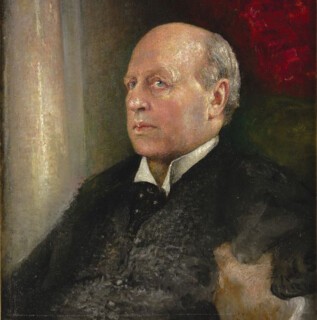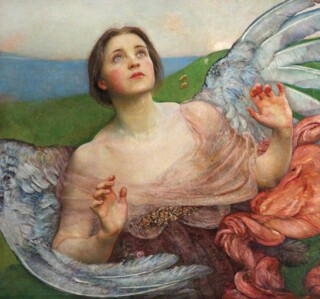A portrait of Henry James hangs in the Strangers’ Dining Room at the Reform Club. The picture was acquired in 2008, and is on the same red wall as portraits of Dickens and Thackeray. James is seated and sunlight falls on the left temple of his semi-bald head – he’s in his late sixties – and he looks up, distracted, as if someone had just entered the room. It’s a silent scene; there’s no suggestion that anyone has said anything. As in Sargent’s picture of James at the National Portrait Gallery, he wears a tie around a white winged collar, a similar black jacket and perhaps the same charcoal waistcoat, but he’s not as imposing as he is in that more famous portrait, maybe because the Reform picture is unfinished. There’s a blurred left hand at bottom right: had the artist not decided what to do with it?
‘There is no greater work of art than a great portrait,’ James once said. His reaction to Sargent’s portrait was to declare it a ‘first-class, living, resembling, enduring thing’. The Reform portrait is not great, but that’s what makes it a living picture in another way – there’s a polite boredom about James’s expression, his apparent lack of interest perhaps a way to mask himself. The portrait of Thackeray in the Strangers’ Dining Room looks by comparison as if it was the work of an undertaker.
The James painting was worked on over the summers of 1910 and 1911, at Hill House, the Epping home of the hostess and patron Mary Hunter. She was the wife of a coal baron and said it was her ‘sacred duty’ to spend all her husband’s money. In that ambition she seems to have been mostly successful. James, Rodin, Thomas Beecham, Edith Wharton, Sargent were among her many fans and beneficiaries. In August 1911, James wrote to Alice, his sister-in-law, and explained why he was at Hunter’s house. ‘I am adding day to day here, as you see – partly because it helps to tide me over a bad – not physically bad – time, and partly because my admirable and more than ever wonderful hostess puts it so as a favour to her that I do, that I can only oblige her in memory of all her great goodness to us – when it did make such a difference – of May 1910.’ He was referring to the death of his brother William. He then told Alice that Mrs Swynnerton was ‘doing – finishing – the portrait of me that she pushed on so last year’.
Doing, finishing, pushed – James isn’t pleased with the picture. Mrs Swynnerton was Annie Swynnerton; she doesn’t seem to have been pleased with the picture either – it remained in her London studio until she died in 1933 (a Washington Post correspondent saw it there in the late 1920s). And the portrait isn’t among the Swynnerton paintings now on show at Manchester Art Gallery (until 6 January 2019), the first exhibition of the artist’s work since 1923, when the gallery celebrated her election to the Royal Academy. She was the first woman to be elected to the RA (Angelica Kauffman and Mary Moser were founding members and appointed not elected), if only as an associate member. So this Swynnerton exhibition is Manchester’s way of celebrating the 250th anniversary of the RA, while also marking the hundredth anniversary of the Representation of the People Act, the legislation that allowed women over the age of thirty to vote. Swynnerton was a suffragette. Her vocation as an artist made it almost impossible for her not to be one. ‘I am much gratified at the honour bestowed upon me,’ she said on learning of her election to the RA, ‘but true art needs no incentive; its work is its own reward.’
Annie Swynnerton was born Anne Louisa Robinson in Manchester in 1844, one of the four daughters of a legal clerk and his wife. She went to Manchester Art School in 1871, as did her sisters Emily and Julia, where they were all prize-winning students, though frustrated by the scope of the tuition available to women and the restrictions imposed on the rewards. Life classes weren’t then available to women, and women weren’t allowed to exhibit at the Manchester Academy of Fine Art, which meant they had less chance to sell their work. Wilkie Collins described the taste and enthusiasms of the self-made industrialists of the mid-19th century: they wanted paintings, he said, with ‘interesting subjects, variety, resemblance to nature, genuineness of the article, and fresh paint’. So there was money in new art – the Pre-Raphaelites were favoured in Manchester – but not for Annie and her sisters, or for her best and lifelong friend, Isabel Dacre, her exact contemporary. Annie’s 1880 portrait of Isabel, titled A mon amie, is in the Manchester show, and in its unadorned way and its lack of unnecessary flattery reveals her view of portraiture. Recognition within the Academy that the Robinson sisters and Dacre had been overlooked came in 1875 when they were made ‘lady exhibitioners’. But that didn’t guarantee that their pictures would actually be shown.
With their prize money, Annie and Isabel set off for Europe, spending two years in Rome. At some stage Isabel worked for Lord Leighton when he was on Capri, taking notes on his ideas about art. Then they went to the Académie Julian in Paris, founded a few years earlier by a wrestler from the Vaucluse, Rudolph Julian. Students at Julian’s academy were allowed to attend classes as they pleased, and women and men were treated equally, even if the life classes were segregated. Annie went on to paint many nudes, which back then was an act of defiance. The RA didn’t permit women to look at naked models in its classes until 1893. In 1879, on their return to Manchester, Annie and Isabel, believing themselves once more rebuffed by the Manchester Academy, launched the Manchester Society of Women Painters. They held three exhibitions of their work and of other women artists.
Isabel would go on to exhibit pictures at the Salon in Paris in the second half of the 1880s, but Annie returned to Rome, where she married a sculptor from the Isle of Man, Joseph Swynnerton. Like Annie, Joseph had been keen to get ahead: from Douglas he went to Edinburgh, where an Italian family called Salvani encouraged him to go to the Accademia di San Luca, a Roman art school. He arrived in 1869, when the Risorgimento was in its final phase. On 20 September 1870, he witnessed the celebrated breakthrough at Rome’s Porta Pia by Victor Emmanuel’s troops – the decisive last moment of the Reunification. He was befriended by Garibaldi, whose bust he made; two years later he won the Accademia’s gold medal for sculpture and was presented with it by the pope. That guaranteed a career.
Exactly when Annie and Joseph met isn’t known – on her first visit to Rome, maybe, or in Paris – but they married in 1883, a year after the Married Women’s Property Act. In their book Annie Swynnerton: Painter and Pioneer (Sarsen Press, £11.99), Penny Morris and Christine Allen say it would have been implausible for Swynnerton to marry before that legislation became law, such was her commitment to equal rules for men and women. A pattern emerged in Annie and Joseph’s lives. They worked in Rome; they exhibited in Manchester and London; they joined the Italian Alpine Society and climbed the peaks of the Apennines. They were a very married pair. Watts and Burne-Jones were Swynnerton’s inspiration. ‘The first time I met Burne-Jones he said to me: “Isn’t it wonderful to have a blank space given to one, entirely of one’s own to make beautiful.”’ She explained how she went about her work. ‘My symbolic pictures just evolve,’ she said. ‘I see something beautiful and there is an idea. As I work, something comes and so the picture grows under my brush. All my work is done out of doors. I work in months. July is a favourite month of mine. I like the quality of the sunlight then. One of my most successful pictures was painted in a succession of six Junes.’ If she’d had another four Augusts at Hill Hall, might she have finished her portrait of Henry James?
Rodin bought one of Swynnerton’s paintings and gave it to the Musée du Luxembourg in Paris. Sargent bought Swynnerton’s most dynamic work, Oreads. A group of nymphs are at the top of a tree seeing out a flood that has overwhelmed the woodland where they live – the water froths about their feet, there’s a fish out of water. The authors of the catalogue for this year’s Swynnerton show, Painting Light and Hope (Manchester Art Gallery, £14.99), identify the picture’s sculptural qualities, and this may have been a result of an artistic alliance with her sculptor husband. Yes, the group does resemble figures for a stone fountain, but it’s the Mediterranean sun on the naked nymphs at a moment when their plight looks desperately uncertain that’s more the thing. Sargent bought the picture when it was first exhibited and years later gave it to the Tate: an established artist making a gift of the work of a less successful artist was an important means of promotion for artists such as Swynnerton. She was elected to the RA the same year – 1922. ‘I hope you share my great enthusiasm for Mrs Swynnerton’s work,’ Sargent wrote. ‘I think her one of the best artists in England and I admire the power and the volume of this particular picture.’
Success allowed Annie and Joseph to acquire a plot of land on the Via Montebello overlooking the garden of the new British embassy in Rome. I went looking for it two years ago, and I think I found it. The street numbers have changed but my guess is that the Swynnerton house is number 114. The stone mullion windows on the building look unlike any other on the street. A Swynnerton friend who travelled to Rome with her in 1930 – Joseph died in 1910 – was stunned by what she saw. ‘This is a wonderful house – so beautifully clean – wonderful – the roof garden and studios are delightful. The marble steps, the great doors, painted ceilings – all luxury. Why doesn’t Mrs S. live here always in comfort?’
In his remarkable book about the decay, destruction and conservation of art, Condition: The Ageing of Art (2015), Paul Taylor reminds his readers of the fragility of artistic endeavour: 95 per cent of all the art produced by the Dutch has been destroyed, and if it’s not 95 per cent, then it’s 99. A reputation that’s forgotten is often all that’s required for an artist’s work to vanish completely. Swynnerton was invited to design the entrance to the British pavilion at the Chicago World Fair in 1893. The story of Florence Nightingale was her subject. The picture disappeared when the fair closed. After Swynnerton died, the contents of her studio were sold at Christie’s – the portrait of James among them. The fate of the house in Rome was more extreme. Swynnerton had British and Italian wills, but because the Italian will wasn’t made on Italian soil, the Fascist authorities said it had no legal standing, and the house was embezzled by a tenant who lived on the top floor. So were the contents of Swynnerton’s Italian bank account. Attempts to wrest the house back after the war failed. As for the paintings left in the house, who’s to say what happened to them?
My father, Hugh Thomas, was a Swynnerton. Last year, after his death, when we were emptying the attic of my parents’ house, a trunk was found in a dark corner and taken down to be looked at. Inside it was the missing original manuscript of his book The Spanish Civil War. The initials on the trunk were A.S. There’s only one A.S. in my family.
Send Letters To:
The Editor
London Review of Books,
28 Little Russell Street
London, WC1A 2HN
letters@lrb.co.uk
Please include name, address, and a telephone number.



